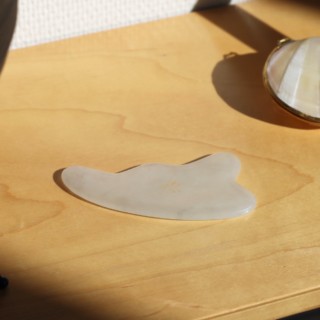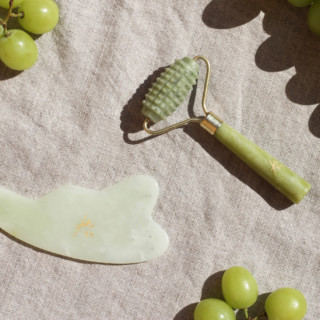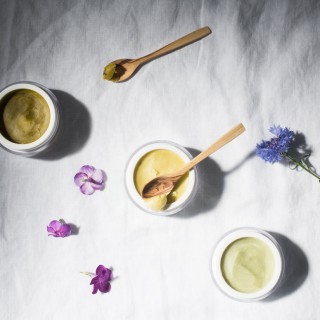A facial gua sha brightens and tightens the skin, fades fine lines and wrinkles, reduces puffiness, accentuates the contour of the face and can relieve skin issues. Why does it work so well?
Gua sha has quickly become a hot topic among natural cosmetics and holistic beauty consumers and sceptics alike. Many who have resorted to injectables in the past have jumped on the bandwagon, deciding to comb their face with a stone instead. The effects of a facial gua sha cannot be disputed, and it’s possible to gain spa-like results even at home if you master the technique. But what exactly makes gua sha so effective?
Facial gua sha, which I’m trained in, combines traditions and techniques of traditional gua sha found in Chinese medicine as well as connective tissue massage and lymphatic drainage. It has been specifically developed as a beauty treatment with diverse effects. The three key effects are:
1. Gua sha invigorates circulation
Strokes with a gua sha tool invigorate the cutaneous circulation. Good circulation is the be-all and end-all to healthy skin, as blood nourishes every cell in the organism, the nervous system and hormonal activity, which participates in all of the body’s metabolic processes. Blood transports oxygens and nutrients to cells and tissues. Stroking the skin with a gua sha tool invigorates blood circulation in the dermis, and oxygen and nutrient-rich blood is transported up into the epidermis to nourish its cells. This improves the skin tone and boosts skin renewal.
Master the techniques of a facial gua sha on the Yin Your Skin® course. Further information here.

2. Gua sha activates the flow of lymph fluids
The lymphatic system removes cellular waste, pathogens, bacteria and other undesirable substances. The lymphatic system doesn’t have a heart to pump it, but needs to be activated with movement. A facial gua sha involves actions and pumping motions to activate the flow of lymphatic fluids, so fluids that contain metabolic waste flow away from tissues, which in turn reduces puffiness, brightens the skin tone and is beneficial for just about any skin issue.
Lymphatic fluids flow downwards and outwards along with gravity. My gua sha teacher Cecily Braden says that blockages in the system cause a so-called ”traffic jam”: cars at the back of the queue (fluids) cannot move until cars at the front move forward.
The lymphatic system reacts to pressure and immobility. Tension in facial muscles and connective tissues are directly linked to stress, which disrupts lymphatic function and circulation. Naturally, the same applies to the entire body.
It’s important to activate the flow of lymph fluids with the right technique. Excess pressure can cause fluids to retreat back into tissues.
Take a look at results customers have gained from doing gua sha at home here.

3. Gua sha activates the function of fibroblast cells
Fibroblast cells produce connective tissue i.e. collagen, elastin and the ground substance for the extracellular matrix that includes e.g. hyaluronic acid. In other words, fibroblasts produce the building blocks for our bodies, forming a three-dimensional network that spans all the way from below the skin to the core. Collagen, elastin and the matrix provide support, strength, flexibility and suppleness to the skin.
Fibroblasts react to mechanical pressure and strain, movement, vibration, hormonal activity, the body’s acidity level and the immune system. Massaging with a gua sha tool causes mechanical friction to connective tissue, which activates the function of fibroblasts. This has a vital effect in treating wrinkles and saggy tissues, as aging causes the number of fibroblasts to decrease and slow down. In addition to aging, inflammation, low-grade inflammation, lack of exercise and stress weaken the function of fibroblasts, causing sagginess and wrinkles, i.e. premature aging.
Massaging with a gua sha tool causes fluids that contain free radicals to flow away from connective tissue. The massage results in tissues becoming refilled with fresh, clean fluids, salts and nutrients. Activating fibroblasts boosts the production of the skin’s own moisturizers causing skin to become “enriched” and wrinkles to fade.
Stress weakens circulation, the flow of lymph fluids and fibroblast function. Whether we want it to or not, the face shows signs of stress. We clench our teeth or strain facial muscles, which causes tension also in connective tissue. Chronic tension causes blockages in lymph circulation as well as wrinkles resulting from facial expressions and facial strain – when tensed up, connective tissue ligaments get packed together and are prone to drying and tightening as opposed to their criss-cross pattern when supple. Gua sha massage relieves tension in connective tissue and ”reorganizes” collagen fibers, making skin more supple; the general appearance of the face becomes relaxed and the skin rests more naturally on bone structure. This is topped with reduced puffiness, accentuating the features of the jawline and cheekbones. Also the eyes look larger, as they no longer appear as deep-set due to swollen skin.

Technique for a facial gua sha
A facial gua sha involves a specific technique, which needs to be mastered correctly to achieve the desired results. The most common mistakes include applying too much pressure (instead of heightening results, exerting pressure actually weakens them), too large an angle, lack of or wrong way of anchoring with the other hand, and not using the right technique for activating lymph flow. Similar results can be achieved by just using your hands, but a purpose-designed tool boosts results and makes the massage easier to perform, especially when doing it to yourself.
The Yin Your Skin® course will help you master fool-proof basic techniques for a facial gua sha. You will also learn yin yoga and meditation, which can be described as beauty treatments for the body and face. The beneficial effects of gua sha equally apply to yin yoga. The course also teaches you the most effective skincare methods – external skincare has its place, too. As you add routines that work form the inside, you may notice having to rely less on external products, though. Purchase the course here.

Photos Ina Nordbäck
Translation Rebecca Watson














